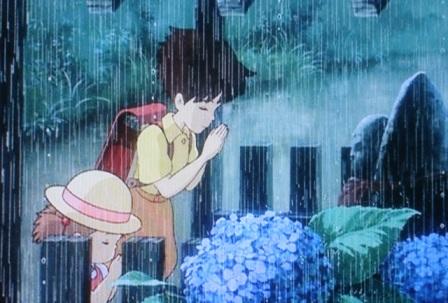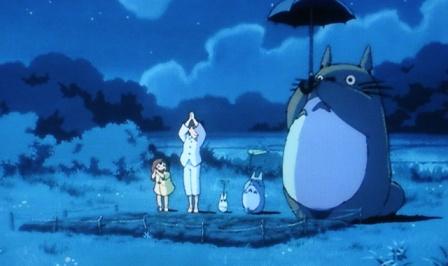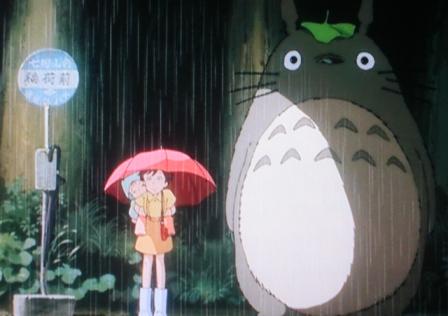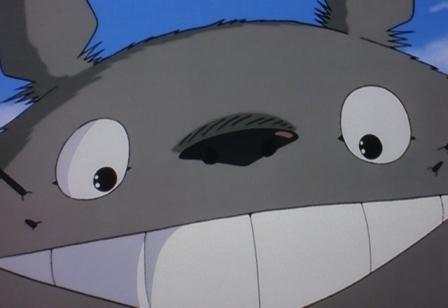MY NEIGHBOR TOTORO [1988]
Flash
Gordon (Anime Corner
Staff Writer)
Pioneer Elite Plasma Display
System PDP-5050SX
Denon AV Surround Receiver AVR-1801 with Dolby Digital/ DTS
Boston Acoustics Micro90T Die-Cast Surround Speakers including Subwoofer
Toshiba DVD SD-3755 Player with Dolby Digital/ DTS/ 3D Surround Sound.
MOTION PICTURE
G RATING
A- ANIMATION
A CHARACTER
A MECH/ CREATURE DESIGN
A- MUSIC
A STORY
A- FILM GRADE
STUDIO: STUDIO GHIBLI
DIRECTOR: HAYAO MIYAZAKI
PRODUCER: TORU HARA/ STUDIO GHIBLI
ANIMATOR: HAYAO MIYAZAKI/ YOSHIHARO SATO [supervisor]
DESIGNS: HAYAO MIYAZAKI
SCRIPT: HAYAO MIYAZAKI
MUSIC: JOE HISAISHI
THEME SONG: ‘HEY LET’S GO’ [US opening theme] JOE HISAISHI featuring SONYA ISAACS
‘MY NEIGHBOR TOTORO’ [US closing theme] JOE HISAISHI featuring SONYA ISAACS
‘SANPO [STROLL]’ [Japan opening theme] AZUMI INOUE
‘TONARI NO TOTORO’ [Japan closing theme] AZUMI INOUE
DVD EXTRAS: BEHIND THE MICROPHONE WITH DAKOTA FANNING AND ELLE FANNING/ COMPLETE STORYBOARDS- GET AN INSIDER’S LOOK AT THE FILM’S ARTISTRY/ ORIGINAL JAPANESE TRAILER/ OPENING AND CLOSING ANIMATION [WITHOUT CREDITS]
|
| DVD
BREAKDOWN |
OTHER
WORKS BY HAYAO MIYAZAKI |
My Neighbor Totoro DVD
|
NAUSICAA OF THE VALLEY OF THE WIND [1984]
LAPUTA: CASTLE IN THE SKY [1986]
KIKI’S DELIVERY SERVICE [1989]
PORCO ROSSO [1992]
PRINCESS MONONOKE [1997]
SPIRITED AWAY [2001]
HOWL’S MOVING CASTLE [2004]
|
| REVIEW
(Warning: Spoilers Ahead!) |
Rule: Fans of anime are always fans of Hayao Miyazaki. Fans of Hayao Miyazaki [and other Studio Ghibli productions] are not always fans of anime.
Yes, ho hum another Hayao Miyazaki cinematic masterpiece for the world to adore. The man is a maestro of animating genius and nails pure unadulterated magic into every thoughtful story. It’s certainly no easy task to come up with one masterpiece, let alone one after another in film and do it at Miyazaki’s level, but Miyazaki does it every time. He is one of the elite talents out there that is able to out-Disney Disney. In fact, My Neighbor Totoro [Tonari No Totoro] may be one of his most Disneyesque pictures ever. His films often contain the magical qualities of Disney and My Neighbor Totoro may be the sentimental favorite that gets you weak in the knees like Bambi. Like Kiki’s Delivery Service it soars with enchantment and the ‘feel good’ factor registers off the charts. Walt Disney would agree by striking a licensing deal with Studio Ghibli for distribution of each and every one of his works stateside along with other studio productions. Tip of the cap to Mickey for that move! My Neighbor Totoro is a family gem, pure and simple, because it is a work that timelessly reaches generations with its wholesome innocence. It is powerfully moving in its understated, simple joys. It is considered his finest moment. Truth be told, a case for his ‘best’ could easily be argued and endlessly debated for each one of his cinema treasures.
My Neighbor Totoro focuses on the daily life of two young sisters, Satsuki and Mei, who move to the country with their father while their mother mends in a nearby rural hospital. The adorably likeable girls are led into a kind of Alice In Wonderland-like spirit world and we witness their joy-filled freedom through their wide-eyed wanderlust. Mei and Satsuki discover cute, but dirty ‘soot’ sprites in their new home. Their wise, older
 neighbor they call Granny smiles upon their discovery. She knows only through a child’s eyes of wonder can these creatures be seen. It is their first encounter with the forest spirits and the introduction of Miyazaki’s tender message of harmony within the world between man and nature, the past and present; he so eloquently merges into his tales. Forest spirits and the spiritual world are often stunningly represented in Miyazaki’s fantasies [Spirited Away, Princess Mononoke] as a reminder of our living Earth. Through his fearless, young protagonists, the audience is awakened to the ancient past and nature. Miyazaki allegorically sprinkles Buddhist temples and shrines across his landscape symbolizing his attempts at reconciling the beauty of past tradition with modern culture. Miyazaki’s colorfully painted forest characters represent the children’s mental connection to the natural treasures to be discovered in the physical world. Before long, Little Mei spots and follows two small mini-Totoro creatures down a proverbial ‘rabbit-hole’ straight out of Lewis Carroll’s literary classic [Alice In Wonderland], except Miyazaki’s homage is through a rooted grove of bushes tunneling under brush that leads to an incredibly muscular and fantastic camphor tree. Through a hollowed chute Mei stumbles down inside the tree and is greeted by a warm cavity where nestled, slumbers the gigantic and fluffy Totoro. Totoro is a wonderfully over-stuffed Pokémon of sorts, a simple but spectacular looking beast. Miyazaki’s further Alice In Wonderland-styled deference comes by way of an immense, orange, magically propelled, 12 legged, grinning cat bus that looks eerily like the infamous Cheshire cat from Carroll’s story or the Walt Disney film version. [In 2003, Miyazaki created a film short for the Studio Ghibli Museum called Mei To Konekobasu or Mei And The Kitten Bus exclusively for visitors]. Totoro may be one of the most endearing and loveable animals ever imagined for the anime screen. The furry plump giant with striking claws is as gentle as a butterfly. Overcome with an ebullient happiness, Mei grabs the massive, cuddly, bear-like Totoro with innocent, eye-popping wonder and ever-trusting zeal. When Totoro’s big eyes meet Mei’s big, sweet smile, it’s not only love at first sight for them but for us too. They bond instantly. Totoro bellows and flashes a wide-toothed grin as only a forest god welcoming pure goodness could. This scene is a classic in the annals of anime moments. The scene leaves you smiling from ear to ear and there are many other moments like this. The rainy bus stop sequence involving a clever and memorable interplay between Totoro and Satsuki holding umbrellas is another remarkable one. It is unforgettably frozen in time the moment you watch. The girls’ playful childhood existence is made only more magical by chasing down golden acorns, growing trees with Totoro, mini-Totoro and itty, bitty wee Totoro and gliding through the sky winds above the beauty of the forest. They learn to enjoy and respect their newfound surroundings with their newfound friends. The film’s only
neighbor they call Granny smiles upon their discovery. She knows only through a child’s eyes of wonder can these creatures be seen. It is their first encounter with the forest spirits and the introduction of Miyazaki’s tender message of harmony within the world between man and nature, the past and present; he so eloquently merges into his tales. Forest spirits and the spiritual world are often stunningly represented in Miyazaki’s fantasies [Spirited Away, Princess Mononoke] as a reminder of our living Earth. Through his fearless, young protagonists, the audience is awakened to the ancient past and nature. Miyazaki allegorically sprinkles Buddhist temples and shrines across his landscape symbolizing his attempts at reconciling the beauty of past tradition with modern culture. Miyazaki’s colorfully painted forest characters represent the children’s mental connection to the natural treasures to be discovered in the physical world. Before long, Little Mei spots and follows two small mini-Totoro creatures down a proverbial ‘rabbit-hole’ straight out of Lewis Carroll’s literary classic [Alice In Wonderland], except Miyazaki’s homage is through a rooted grove of bushes tunneling under brush that leads to an incredibly muscular and fantastic camphor tree. Through a hollowed chute Mei stumbles down inside the tree and is greeted by a warm cavity where nestled, slumbers the gigantic and fluffy Totoro. Totoro is a wonderfully over-stuffed Pokémon of sorts, a simple but spectacular looking beast. Miyazaki’s further Alice In Wonderland-styled deference comes by way of an immense, orange, magically propelled, 12 legged, grinning cat bus that looks eerily like the infamous Cheshire cat from Carroll’s story or the Walt Disney film version. [In 2003, Miyazaki created a film short for the Studio Ghibli Museum called Mei To Konekobasu or Mei And The Kitten Bus exclusively for visitors]. Totoro may be one of the most endearing and loveable animals ever imagined for the anime screen. The furry plump giant with striking claws is as gentle as a butterfly. Overcome with an ebullient happiness, Mei grabs the massive, cuddly, bear-like Totoro with innocent, eye-popping wonder and ever-trusting zeal. When Totoro’s big eyes meet Mei’s big, sweet smile, it’s not only love at first sight for them but for us too. They bond instantly. Totoro bellows and flashes a wide-toothed grin as only a forest god welcoming pure goodness could. This scene is a classic in the annals of anime moments. The scene leaves you smiling from ear to ear and there are many other moments like this. The rainy bus stop sequence involving a clever and memorable interplay between Totoro and Satsuki holding umbrellas is another remarkable one. It is unforgettably frozen in time the moment you watch. The girls’ playful childhood existence is made only more magical by chasing down golden acorns, growing trees with Totoro, mini-Totoro and itty, bitty wee Totoro and gliding through the sky winds above the beauty of the forest. They learn to enjoy and respect their newfound surroundings with their newfound friends. The film’s only
 restlessness and unease comes when Mei disappears in an attempt to visit her ailing mother. Totoro becomes Mei and Satsuki’s savior. The film gradually unfolds offering a ‘slice of life’ window into the lives of Satsuki and Mei. It is a vibrant, picturesque one at that. There is little urgency or conflict here, just a sweet, meandering quality to the picture and the many colorful characters that touch the youngsters’ lives. You’ll be wishing the world were filled with neighbors like Totoro, Granny, Mei or Satsuki. This Miyazaki film is all heart.
restlessness and unease comes when Mei disappears in an attempt to visit her ailing mother. Totoro becomes Mei and Satsuki’s savior. The film gradually unfolds offering a ‘slice of life’ window into the lives of Satsuki and Mei. It is a vibrant, picturesque one at that. There is little urgency or conflict here, just a sweet, meandering quality to the picture and the many colorful characters that touch the youngsters’ lives. You’ll be wishing the world were filled with neighbors like Totoro, Granny, Mei or Satsuki. This Miyazaki film is all heart.
Miyazaki places many subtle messages throughout his work combining quality film entertainment with important thematic elements. The strong bonds between Satsuki, Mei, their father and mother will make you laugh and illustrates Miyazaki’s important message of respect and love. Miyazaki exemplifies these important themes through character action. The girls lightheartedly remind you of moments from your own spirited upbringing. The film perfectly captures the feeling of those liberating early years running unhampered through the yard or a field with overactive imaginations and only the wonderment of discovery as your boundary. Master Miyazaki brings it all to heartfelt, radiant life. Miyazaki offers trademark entertainment combined with quiet power, social statement and strong environmental advocacy without coming off preachy. He manages to create storybook films that not only entertain but also enlighten. Miyazaki’s deep respect for heritage and reverence for his Japan homeland is inspiring and feeds his socio-cultural worldview, which he intentionally weaves into film. His experiences translate beautifully into a universal language for filmgoers. He has often complained the young in Japan [the same holds true outside of Japan] have lost touch with their natural surroundings. He makes a point of reminding us through film of this imperative fragility and balance that must prosper for our survival. Such a scene is deftly illustrated in My Neighbor Totoro when the girls, led by their father, stand before the great camphor tree and pray. The father as teacher: “Magnificent tree, it’s been around since long ago, back in the time when trees and people used to be friends. When I saw this tree I knew this would be a good place
 for our family to live… so let’s give this tree a nice greeting… thank you for watching over Mei and making us feel so welcome here. Please continue to look after us.” This is strong, believable writing emphasizing the crucial message of harmony with the land. His substantive concerns, combined with his masterful animation and eloquent and insightful storytelling charms generate some of the most prized animated films ever made and My Neighbor Totoro is high on the list. Indeed, Miyazaki is a special talent and a special influence in film.
for our family to live… so let’s give this tree a nice greeting… thank you for watching over Mei and making us feel so welcome here. Please continue to look after us.” This is strong, believable writing emphasizing the crucial message of harmony with the land. His substantive concerns, combined with his masterful animation and eloquent and insightful storytelling charms generate some of the most prized animated films ever made and My Neighbor Totoro is high on the list. Indeed, Miyazaki is a special talent and a special influence in film.
Miyazaki’s enchanting tales also execute an acute sense of place given his strong adherence to Japanese tradition. Each and every one of his films has a refreshing Japanese flavor alongside his many original and fanciful ideas. The animation is particularly un-American, despite global themes. It’s no slight of American filmmaking. It’s just refreshing to experience actual location shots from another part of the world and see a director remain true to his vision. In the best possible sense, his work invites you to a different place, touched by a different culture that is, as you might expect, definitively Japanese. You experience spaces, ideas, emotions that are composed in a uniquely different way. It’s like a gift on Christmas morning. Miyazaki combines his fantastic concepts with his rich Japanese history and blends his own special, romantic touch that invites all people to experience his unique style of filmmaking. It is important to open one’s mind to cultural exchange. It’s easy to fall prey to the narrow view of Disney films as spectacular as they are. The American-centric filmgoer may need a little coaxing, but as filmmakers like Miyazaki come along it broadens the horizons of the film going public just a little bit more. This is the beauty of film isn’t it? It’s the ability to bring the world to your home and children when you can’t take them there.
My Neighbor Totoro wasn’t on my radar at all, yet it was one of the final Miyazaki films on my list to see. The last thing you might want to bring home to the kids is another American animated film loaded to the hilt with potty humor. The formula is tiresome and superfluous. There are enough uses of ‘stupid’ and ‘idiot’ from those films to last a lifetime. It’s just not funny. Like it or not my daughter was about to see My Neighbor
 Totoro. It took us all by surprise. It was funny, cute, endlessly entertaining, all that and more. We were blown away. It easily rivaled Kiki’s Delivery Service. It may have something to do with appealing to the inner child and the child-like wonder that permeates every cel of this film. It amplifies every thing great about being a kid and the explosive joy to explore bursting from every fiber of their being. Kiki’s coming-of-age adventure is caught up in those adolescent appeals, but just as inviting to youngsters. This one is for those who still remain an utter child at heart. My Neighbor Totoro serves up popcorn picture perfection for the family. It’s a fantastic example of why some anime never grows stale or outdated. It’s also proof positive it’s never too late to look back at those past anime classics. The film inspires a re-evaluation of Miyazaki’s catalogue with new eyes. It’s a treat.
Totoro. It took us all by surprise. It was funny, cute, endlessly entertaining, all that and more. We were blown away. It easily rivaled Kiki’s Delivery Service. It may have something to do with appealing to the inner child and the child-like wonder that permeates every cel of this film. It amplifies every thing great about being a kid and the explosive joy to explore bursting from every fiber of their being. Kiki’s coming-of-age adventure is caught up in those adolescent appeals, but just as inviting to youngsters. This one is for those who still remain an utter child at heart. My Neighbor Totoro serves up popcorn picture perfection for the family. It’s a fantastic example of why some anime never grows stale or outdated. It’s also proof positive it’s never too late to look back at those past anime classics. The film inspires a re-evaluation of Miyazaki’s catalogue with new eyes. It’s a treat.
The animation is warm and the pastoral scenery is filled with lush, rolling green hills, bushy trees and blue skies. It’s like a watercolor canvas come to life. Miyazaki’s gorgeous, hand-painted backdrops always take the breath away like staring out at the vast sea or a mountains skyline. The details are astounding from tree roots to bugs on a plant stem. Key animation contributions apart from Studio Ghibli came by way of upstart Madhouse in the day.  The new transfer does this classic exceptional justice as only Walt Disney lovingly can restoring all the Studio Ghibli productions for US distribution. The transfer of the color palette is about as vibrant as a transfer gets circa 1988.
The new transfer does this classic exceptional justice as only Walt Disney lovingly can restoring all the Studio Ghibli productions for US distribution. The transfer of the color palette is about as vibrant as a transfer gets circa 1988.
The English voice dub is splendidly cast by selecting sisters Dakota and Elle Fanning to play the parts of Satsuki and Mei respectively. Their genuine chemistry is natural and the sibling banter true to life enhancing Miyazaki’s affecting intentions. As far as composers of choice, Mamoru Oshii often turns to Kenji Kawai, Hideaki Anno to Shiro Sagisu, while Miyazaki turns to mainstay confidant Joe Hisaishi. He pumps up the jubilation factor with a wonderful score and two bouncy numbers [‘Hey Let’s Go’ and the Miyazaki penned ‘My Neighbor Totoro’] sung with vigor compliments of effervescent country pop singer Sonya Isaacs [not sounding too country here]. These are the English translations of their Japanese counterparts. Sadly, all of the Walt Disney versions of these gorgeous Studio Ghibli theme songs are unavailable for purchasing anywhere. Unlike some anime theme music these songs fittingly corroborate the framework of the story and its characters. They are endlessly singable or hummable [if you’re listening to the Japanese import]. The biggest disappointment is the lack of a 5.1 Dolby Digital mix as it settles for a basic 2.0 soundtrack. It would have been terrific to hear the rain falling, the cicadas singing or Totoro bellowing his growls in a booming, layered, varied, punctuated surround sound environment like many of the Studio Ghibli releases.
This is a delightful family film and the obvious antithesis and panacea to the more downbeat and heartbreaking Grave Of The Fireflies* released the same year. My Neighbor Totoro is filled with hope and overflowing with bliss. When it comes to charming and fantastical My Neighbor Totoro is a winner. You’ll
 know it’s a film qualified for repeat viewing when your child sits on your head at 6:30 AM and pleads, “Daddy, can we please watch ‘Me And Totoro’?” You can imagine my Totoro-like grin and Mei-like joy when I, too, got to watch it again. So when those winds blow against your face and through your fingers, try and remember those friendly forest spirits that surround you.
know it’s a film qualified for repeat viewing when your child sits on your head at 6:30 AM and pleads, “Daddy, can we please watch ‘Me And Totoro’?” You can imagine my Totoro-like grin and Mei-like joy when I, too, got to watch it again. So when those winds blow against your face and through your fingers, try and remember those friendly forest spirits that surround you.
*Footnote: At first glance, it’s hard to imagine My Neighbor Totoro was double-billed with another Studio Ghibli production Grave Of The Fireflies upon release. Both films offer theatrical excellence by their respective directors, Hayao Miyazaki and Isao Takahata. It was the differing content that raised eyebrows. My Neighbor Totoro is lighter family entertainment by comparison while Grave Of The Fireflies is a harrowing, hardcore depiction of two children starving in Japan as a result of a shortage in the food supply during World War II. Roger Ebert was a fervent advocate of Grave Of The Fireflies, but also praised My Neighbor Totoro as “one of the most beloved of all family films.” For some, it seemed an odd decision to release and show them together. The stories capture the lives of innocent children affected by diametrically opposite external forces. Nonetheless, they are two masterstrokes depicting different events. Despite this, it was an interesting juxtaposition to have them released simultaneously painting a powerful parallel of two alternate portraits of life in the Japanese countryside based upon significantly dissimilar sets of variables. One thing is certain, the day both productions were released two classics were born.

